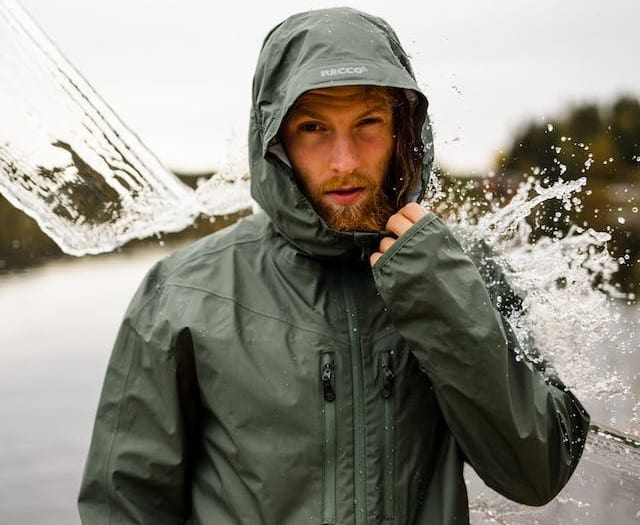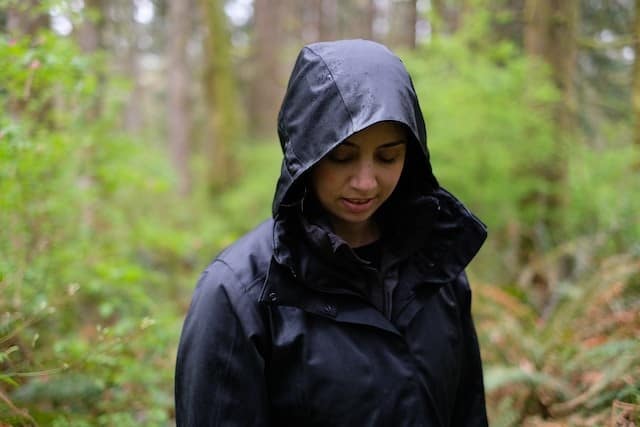
As outdoor enthusiasts, we constantly seek gear that allows us to embrace the elements without compromise. Enter the science behind waterproof rain jackets. Understanding the technology that keeps us dry, comfortable, and ready for any adventure is vital. From the innovative materials to the intricate engineering, decoding the magic behind waterproofing is a game-changer.
Join us as we unravel the secrets of waterproof rain jackets, shedding light on the nanotechnology, breathable membranes, and durable water-repellent (DWR) finishes that make modern outerwear a technical marvel.
Understanding waterproof rain jackets
When it comes to practicing outdoor activities, having the right gear is crucial. Waterproof rain jackets like the ones you can find at Dwights Outdoors are essential for staying dry and comfortable in wet conditions, whether hiking, camping, or simply navigating through everyday life. Gone are the days of bulky, non-breathable raincoats that left us feeling clammy and restricted.
Today’s waterproof jackets result from cutting-edge technology and advanced materials that provide superior protection without sacrificing comfort or style. Understanding the science behind these jackets allows us to make informed decisions when choosing the right gear for our outdoor pursuits.
Waterproof rain jackets are designed to keep water out while allowing moisture vapor to escape, creating a breathable and dry environment for the wearer. The technology behind these jackets involves a combination of specialized materials and construction techniques that work together to repel water and provide comfort in various weather conditions. With the evolution of outdoor gear, waterproof rain jackets have become an essential part of any adventurer’s wardrobe, offering reliable protection against the elements without compromising performance.
Deciphering the intricacies of waterproof rain jackets involves delving into the innovative materials and construction methods that make them effective. Every aspect of these jackets is engineered to provide maximum protection and comfort, from high-performance fabrics to advanced seam-sealing techniques. By understanding the science behind waterproofing, outdoor enthusiasts can make really informed choices when selecting the right jacket for their specific needs, ensuring that they stay dry and comfortable during their outdoor pursuits.
The science behind waterproofing
The science behind waterproofing revolves around repelling water while allowing moisture vapor to escape, creating a breathable and dry microclimate inside the jacket. This involves a combination of specialized materials, coatings, and construction techniques to achieve waterproof and breathable properties. Understanding the science behind waterproofing is essential for outdoor enthusiasts seeking reliable protection without compromising comfort or performance.
One of the critical elements of waterproof rain jackets is using advanced materials such as laminates, membranes, and coatings engineered to repel water while allowing air to pass through. These materials are specially designed to create a barrier against rain, snow, and moisture, keeping the wearer dry and comfortable in different weather conditions. Additionally, the construction of waterproof jackets involves seam-sealing methods and design features that prevent water from penetrating the garment, ensuring maximum protection for the wearer.
The science behind waterproofing also encompasses the concept of durable water-repellent (DWR) finishes, which are applied to the jacket’s outer fabric to enhance its water resistance. DWR treatments create a surface tension that causes water to bead up and roll off the fabric, preventing it from saturating the outer layer. This technology, combined with breathable membranes and advanced materials, contributes to the overall effectiveness of waterproof rain jackets, making them an indispensable piece of gear for outdoor enthusiasts.

How waterproof rain jackets work
Waterproof rain jackets utilize advanced materials, construction techniques, and design features to repel water while allowing moisture vapor to escape. The key to their effectiveness lies in integrating breathable membranes, durable water-repellent (DWR) finishes, and seam-sealing methods that work together to create a barrier against moisture—understanding how waterproof jackets work is essential for maximizing their performance in various outdoor activities.
Breathable membranes, such as Gore-Tex and eVent, are integral to the functionality of waterproof rain jackets. These membranes are engineered to have microporous structures that allow water vapor to pass through while preventing liquid water from penetrating the fabric. This enables the jacket to remain waterproof from the outside while allowing sweat and moisture vapor to escape, keeping the wearer dry during physical exertion.
In addition to breathable membranes, waterproof rain jackets are often treated with durable water-repellent (DWR) finishes to enhance their water resistance. DWR treatments cause water to bead up and roll off the fabric, preventing it from saturating the jacket’s outer layer. Combined with breathable membranes, DWR finishes contribute to the overall effectiveness of waterproof jackets, ensuring that the wearer remains protected from the elements without feeling clammy or restricted.
The construction of waterproof rain jackets also plays a crucial role in their functionality. Seam-sealing methods, such as taped or welded seams, prevent water from penetrating the garment through the stitching. Waterproof jackets can maintain their integrity and keep water out by sealing the seams, providing reliable protection in rainy and wet conditions. Understanding how these elements work together allows outdoor enthusiasts to make informed decisions when choosing the right waterproof rain jacket for their adventures.
Different types of waterproof materials
Waterproof rain jackets are made from various materials, each offering unique properties and performance characteristics. Understanding the different types of waterproof materials is essential for selecting the right jacket that meets specific outdoor needs and preferences. The choices, from high-performance laminates to traditional waxed fabrics, are diverse, catering to various outdoor activities and environments.
Gore-Tex is one of the most well-known and widely used waterproof materials in the outdoor industry. Its breathable membrane provides durable waterproof protection, making it really ideal for a wide range of outdoor activities. Gore-Tex jackets are known for their reliability and performance, offering superior protection against rain and moisture while allowing moisture vapor to escape, keeping the wearer dry and comfortable.
Another popular waterproof material is eVent, known for its high breathability and waterproof properties. eVent membranes are designed to allow sweat and moisture vapor to escape, making them suitable for high-intensity activities where breathability is crucial. Jackets made with eVent membranes provide reliable protection in wet conditions while ensuring comfort and performance during physical exertion.
In addition to advanced membranes, jackets are made with traditional waxed fabrics, such as waxed cotton and canvas. These materials offer a classic and rugged aesthetic while providing water resistance through their natural wax coating. While less technically advanced than modern membranes, waxed fabrics have a timeless appeal and are suitable for casual outdoor activities where style and functionality are equally important.
Understanding the different types of waterproof materials allows outdoor enthusiasts to choose jackets that align with their specific needs, whether for hiking, camping, travel, or everyday use. By considering each material’s performance characteristics and properties, individuals can make well-informed decisions when investing in a waterproof rain jacket that suits their lifestyle and outdoor pursuits.
Key features to look for in a waterproof rain jacket
When choosing a waterproof rain jacket, there are vital features to consider that contribute to its overall performance and functionality. Understanding these features allows outdoor enthusiasts to select jackets that meet their needs and preferences, ensuring reliable protection and comfort in various outdoor activities and conditions. From breathable membranes to adjustable hoods, the following key features are essential for maximizing the effectiveness of waterproof rain jackets.
Breathable membranes are integral to the functionality of waterproof rain jackets, allowing moisture vapor to escape while providing reliable protection against rain and moisture. Look for jackets with advanced membranes like Gore-Tex or eVent that offer high breathability and waterproof properties, ensuring comfort and performance during physical exertion.
Durable water repellent (DWR) finishes enhance the water resistance of waterproof jackets by causing water to bead up and roll off the fabric. Jackets with effective DWR treatments maintain their waterproofness and prevent water from saturating the outer layer, keeping the wearer dry and comfortable in wet conditions.
Adjustable hoods and cuffs allow for personalized fit and protection, ensuring the jacket can adapt to changing weather conditions and activities. Look for jackets with adjustable hoods and cuffs that can be cinched down for a snug fit, providing reliable protection against wind and rain while maintaining comfort and visibility.
While wearing a waterproof rain jacket, pit zips or ventilation features are essential for regulating body temperature and moisture. Jackets with pit zips or ventilation panels allow for increased airflow and breathability, preventing overheating and moisture buildup during physical activities.
Multiple pockets with waterproof zippers provide convenient storage and protection for essentials such as keys, maps, and electronics. Look for jackets with ample pockets and waterproof zippers that keep valuables secure and dry, offering practical functionality during outdoor adventures.
Understanding the key features to look for in a waterproof rain jacket enables outdoor enthusiasts to make informed decisions when selecting the right gear for their specific needs. By considering these features’ functionality and performance characteristics, individuals can invest in jackets that offer reliable protection and comfort, enhancing their outdoor experiences.

Best practices for staying dry in the rain
While waterproof rain jackets are designed to provide reliable protection against the elements, there are additional best practices that can help outdoor enthusiasts stay dry and comfortable in rainy conditions. Understanding these best practices allows individuals to maximize the effectiveness of their waterproof gear and enjoy outdoor activities without being hindered by wet weather. The following tips are essential for staying dry in the rain, from layering techniques to proper gear maintenance.
Layering is essential to staying dry and comfortable in the rain. By wearing moisture-wicking base layers and insulating mid-layers beneath a waterproof rain jacket, individuals can manage moisture and body temperature more effectively, ensuring comfort and performance during outdoor activities.
Proper gear maintenance is essential for preserving the waterproofness and functionality of rain jackets. Regularly washing and reapplying DWR treatments can enhance the jacket’s water resistance, ensuring that it continues to repel water and provide reliable protection in wet conditions.
Carrying a packable rain cover or shawl is a practical backup solution for unexpected downpours. A lightweight and compact rain cover protects individuals and their gear from rain, ensuring they can continue their outdoor pursuits without being caught off guard by wet weather.
Choosing the proper footwear, such as waterproof hiking boots or trail shoes, complements the effectiveness of waterproof rain jackets. By wearing appropriate waterproof footwear, individuals can ensure that their entire ensemble provides reliable protection against rain and moisture, allowing them to stay dry and comfortable during their outdoor adventures.
Being mindful of weather forecasts and planning outdoor activities can help individuals avoid prolonged exposure to heavy rain and inclement weather. By staying informed and prepared, outdoor enthusiasts can decide when and where to engage in outdoor pursuits, ensuring a more enjoyable and comfortable experience.
Understanding the best practices for staying dry in the rain empowers outdoor enthusiasts to make the most of their waterproof gear and enjoy outdoor activities confidently and comfortably. By incorporating these tips into outdoor routines, individuals can stay dry and comfortable in wet conditions, embracing the elements without compromise.











































